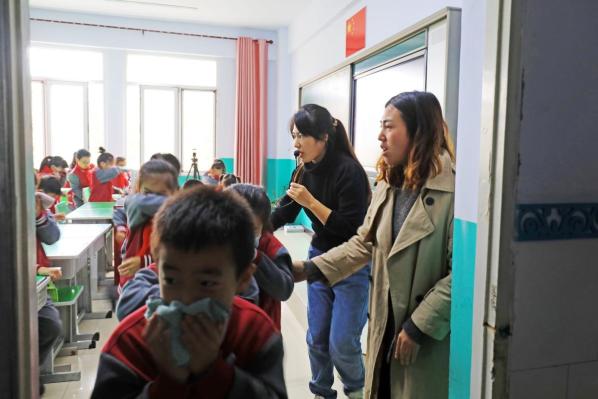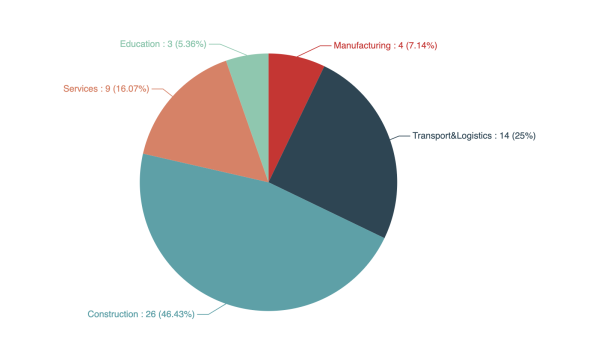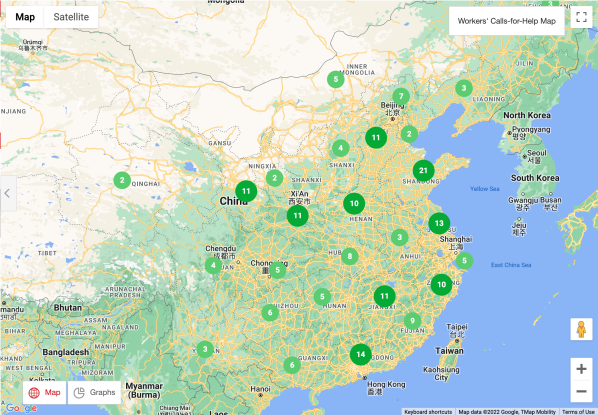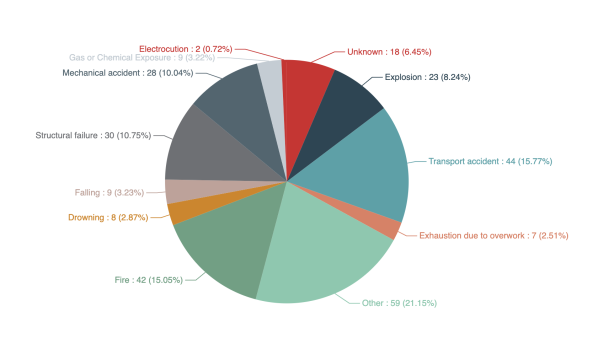
Photograph: chinahbzyg / Shutterstock.com
China Labour Bulletin’s mapping data collected in September 2022 reveals the extent to which local government budgets are stretched, leading to unpaid wages for essential workers like teachers and bus drivers in China’s smaller cities. This is related to the property market crisis, as local revenues from property sales have fallen.
But first, don’t miss the content CLB has published recently:
- One year on, few details available about detention of activists Wang Jianbing and Sophia Huang Xueqin. Journalist Jessie Lau wrote for CLB on the labour rights work of the activist pair who disappeared into state detention on 19 September 2021 and were later charged with “inciting subversion of state power.” They will face trial at an unknown date. Wang Jianbing is a labour and disability rights defender, recently known for assisting workers who have contracted the lung disease pneumoconiosis. Journalist Huang Xueqin conducted a landmark survey revealing that over 80 percent of female journalists have experienced sexual harassment on the job, kickstarting China’s #MeToo movement. In a letter signed by over two dozen civil society organisations, CLB joins the call for the immediate release of Wang and Huang, and, until then, for their cases to be handled in compliance with all relevant domestic and international laws.
- Nurse shortage comes face to face with low pay, inadequate training and the pandemic. The medical industry has met unprecedented challenges as a result of the global pandemic. However, the shortage of nurses and care workers must be understood in the context of a cycle of industry shortcomings that have been prevalent for years. Wages are low, nurses are overburdened, and demand keeps widening the gap. Hospitals are reluctant to hire additional nurses to cope with increased demand, but a lack of public funding and a fee charging mechanism create hiring disincentives, and young workers fear income instability if they enter the industry. Many families have resorted to hiring private care workers, but these workers do not have standardised training and face poor working conditions. Given the rising problem over the past decade and some clear solutions such as raising workers’ pay and labour standards, unions have a role to play in negotiating with employers on behalf of nurses and care workers, thus improving the quality of care for patients, too.
- September 2022 labour news roundup: Peak season labour shortage in manufacturing sector. Each month, CLB selects notable headlines in domestic media and provides a roundup of issues facing workers. In this edition: Manufacturing sector experiences labour shortage during peak season; tech companies eliminate overtime pay for contractual workers; government circular signals possible pay cuts at financial sector SOEs; smaller cities unable to support local bus routes, leaving drivers unpaid; young lawyer takes own life in the face of harsh legal work culture; air conditioning installation accidents surge this summer.
Tight local budgets mean essential workers without pay
In September, the CLB Strike Map and Workers’ Calls-for-Help Map documented examples of the impact on workers of tight local government budgets, including multiple incidents involving teachers and bus drivers.
In one district of Xi'an, Shaanxi province, a teacher wrote online to report that at different schools across the district, the government did not pay teacher allowances in accordance with policies. Regulations state that homeroom teachers receive a standard monthly allowance of 800 yuan at secondary schools and 600 yuan at primary schools. This allowance is to be paid monthly along with any performance adjustment, but the allowances for the entire 2020 school year have yet to be issued.
Teachers in Henan province and Fujian province are also owed performance pay. A primary school in Hubei province owed teachers wages in arrears plus social security benefits, and even delayed the transfer of teachers’ status from contract teachers with lower pay and fewer benefits to being on the preferential government payroll.
Another type of essential worker affected by budgetary constraints is bus drivers. CLB earlier reported on wage arrears in a number of locations in China, and this problem has still not been solved. The pandemic has decreased passenger flow and increased operating costs, and bus companies have suffered serious losses. This is especially the case in smaller cities with more limited resources.
CLB’s mapping data reveals bus drivers seeking help online in several regions. Media reports in Baoding, Hebei province, describe the recent changes to bus drivers’ everyday work, including conducting anti-Covid measures. Drivers complained of this extra burden, declining wages, decommissioning of hybrid vehicles, and route closures. And in Lanzhou, Gansu province, bus drivers for a state-owned enterprise complained of unpaid wages and were told to take out personal loans to cover their salaries.
Both the teachers and the bus drivers seeking pay and benefits reflect the poor financial condition of local governments in China. This situation is due in part to the decrease in revenue from land sales, as China’s property market is in turmoil, but governments have made the choice to not prioritise the salaries and benefits of workers.

Pie Chart: September 2022 Strike Map Data by Industry
The CLB Strike Map recorded a total of 56 incidents in September 2022, a slight increase from August 2022 but only about half the number recorded in September 2019. The rate of collective actions dropped dramatically in 2020 at the start of the pandemic and was steadily rising to meet pre-pandemic levels, until this more recent drop.
The construction industry accounted for almost half the recorded incidents, followed by the transportation and logistics industry and services. Workers largely protested against wage arrears, with about 86 percent of incidents centring on this issue. The scale of workers’ collective actions is still small, but over 20 percent of cases involved 101-1,000 people, an increase in these larger-scale actions compared to the previous month. Although we do not know the outcomes in most cases, in the 30 percent for which official responses are known, the government intervened in about 20 percent, negotiation with management occurred in eight percent, and law enforcement were dispatched in about two percent.

Map: September 2022 Workers’ Calls-for-Help Map
CLB’s Workers’ Calls-for-Help Map recorded 194 incidents of workers across the country posting about their labour disputes, down slightly from August 2022 figures. This map was launched in October 2020, so pre-pandemic data is not available for comparison, but overall trends have roughly tracked those of the Strike Map. Shandong province led with 21 incidents, followed by Guangdong (14) and Jiangsu (13) provinces.
The proportion of incidents in the service sector rose, tying the construction industry for the most incidents at 35 percent each. Over 90 percent of all incidents recorded were for wages in arrears. The proportion of workers seeking government mediation increased significantly from 44 percent in August 2022 to 77 percent in September 2022.

Pie Chart: September 2022 Accident Map Data by Type of Accident
In September 2022, the CLB Accident Map recorded 38 incidents, up from 31 last month. Of the total incidents, 15 were in the mining industry. The most common cause was mechanical accident. Half of the incidents resulted in 1-9 deaths.
A total of ten accidents occurred in Shanxi province alone, all of which were mining accidents. Twelve deaths resulted, and three workers are missing. Four of these accidents involved state-owned enterprises.
Our maps are free and publicly available on our website. Feel free to explore our databases and discover patterns and trends for yourself. You can contact us at clbeditor@clb.org.hk.
